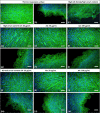Construction of cardiomyoblast sheets for cardiac tissue repair: comparison of three different approaches
- PMID: 31236767
- PMCID: PMC6663965
- DOI: 10.1007/s10616-019-00325-2
Construction of cardiomyoblast sheets for cardiac tissue repair: comparison of three different approaches
Abstract
Recently, cell sheet engineering has emerged as one of the most accentuated approaches of tissue engineering and cardiac tissue is the pioneering application area of cell sheets with clinical use. In this study, we cultured rat cardiomyoblasts (H9C2 cell line) to obtain cell sheets by using three different approaches; using (1) thermo-responsive tissue culture plates, (2) high cell seeding density/high serum content and (3) ascorbic acid treatment. To compare the outcomes of three methods, morphologic examination, immunofluorescent stainings and live/dead cell assay were performed and the effects of serum concentration and ascorbic acid treatment on cardiac gene expressions were examined. The results showed that cardiomyoblast sheets were successfully obtained in all approaches without losing their integrity and viability. Also, the results of RT-PCR analysis showed that the types of tissue culture surface, cell seeding density, serum concentration and ascorbic acid treatment affect cardiac gene expressions of cells in cell sheets. Although three methods were succeeded, ascorbic acid treatment was found as the most rapid and effective method to obtain cell sheets with cardiac characteristics.
Keywords: Ascorbic acid; Cardiac tissue; Cell sheet engineering; H9C2 cell line; Thermo-responsive surface.
Conflict of interest statement
The authors declare that they have no conflict of interest.
Figures







Similar articles
-
Prescription of Controlled Substances: Benefits and Risks.2025 Jul 6. In: StatPearls [Internet]. Treasure Island (FL): StatPearls Publishing; 2025 Jan–. 2025 Jul 6. In: StatPearls [Internet]. Treasure Island (FL): StatPearls Publishing; 2025 Jan–. PMID: 30726003 Free Books & Documents.
-
Psychological therapies for panic disorder with or without agoraphobia in adults: a network meta-analysis.Cochrane Database Syst Rev. 2016 Apr 13;4(4):CD011004. doi: 10.1002/14651858.CD011004.pub2. Cochrane Database Syst Rev. 2016. PMID: 27071857 Free PMC article.
-
Systemic pharmacological treatments for chronic plaque psoriasis: a network meta-analysis.Cochrane Database Syst Rev. 2021 Apr 19;4(4):CD011535. doi: 10.1002/14651858.CD011535.pub4. Cochrane Database Syst Rev. 2021. Update in: Cochrane Database Syst Rev. 2022 May 23;5:CD011535. doi: 10.1002/14651858.CD011535.pub5. PMID: 33871055 Free PMC article. Updated.
-
Systemic pharmacological treatments for chronic plaque psoriasis: a network meta-analysis.Cochrane Database Syst Rev. 2017 Dec 22;12(12):CD011535. doi: 10.1002/14651858.CD011535.pub2. Cochrane Database Syst Rev. 2017. Update in: Cochrane Database Syst Rev. 2020 Jan 9;1:CD011535. doi: 10.1002/14651858.CD011535.pub3. PMID: 29271481 Free PMC article. Updated.
-
Novel application of metabolic imaging of early embryos using a light-sheet on-a-chip device: a proof-of-concept study.Hum Reprod. 2025 Jan 1;40(1):41-55. doi: 10.1093/humrep/deae249. Hum Reprod. 2025. PMID: 39521726 Free PMC article.
Cited by
-
Biological nerve conduit model with de-epithelialized human amniotic membrane and adipose-derived mesenchymal stem cell sheet for repair of peripheral nerve defects.Cell Tissue Res. 2023 Mar;391(3):505-522. doi: 10.1007/s00441-022-03732-8. Epub 2022 Dec 23. Cell Tissue Res. 2023. PMID: 36562866
-
A three-dimensional culture system for generating cardiac spheroids composed of cardiomyocytes, endothelial cells, smooth-muscle cells, and cardiac fibroblasts derived from human induced-pluripotent stem cells.Front Bioeng Biotechnol. 2022 Jul 22;10:908848. doi: 10.3389/fbioe.2022.908848. eCollection 2022. Front Bioeng Biotechnol. 2022. PMID: 35957645 Free PMC article.
-
Optimization of 3D printing and in vitro characterization of alginate/gelatin lattice and angular scaffolds for potential cardiac tissue engineering.Front Bioeng Biotechnol. 2023 May 25;11:1161804. doi: 10.3389/fbioe.2023.1161804. eCollection 2023. Front Bioeng Biotechnol. 2023. PMID: 37304145 Free PMC article.
-
Cardiac tissue engineering therapeutic products to enhance myocardial contractility.J Muscle Res Cell Motil. 2020 Dec;41(4):363-373. doi: 10.1007/s10974-019-09570-6. Epub 2019 Dec 20. J Muscle Res Cell Motil. 2020. PMID: 31863324 Free PMC article. Review.
References
Grants and funding
LinkOut - more resources
Full Text Sources

